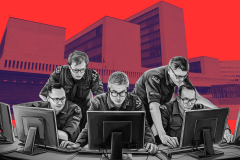Before the coronavirus pandemic, employees appreciated their IT colleagues. When COVID-19 struck, however, more workers than ever before recognized that without technologically savvy team members, their workflows would stumble, falter, or even fail. Why? Because we all immediately (and more than ever before) came to rely on technology in business.
Are you one of those team members who didn’t think about your IT coworkers every day?
Needless to say, just about every company has realized the value and impact of the IT workers at this point. After all, as revealed in a late 2020 McKinsey survey, executives acknowledge that COVID-19 has sped up their adoption of digitalization considerably. Some posit that nearly seven years of technological evolution happened in the span of a few months. Perhaps the strongest evidence of that was within cybersecurity in IT.
Increased Security in the Age of COVID-19
When massive numbers of employees began telecommuting — at home — during COVID-19, many corporate teams met unparalleled security challenges in IT-related procedures. Not surprisingly, hackers tried to take advantage of the situation, resulting in an 800% increase in reported ransomware attacks, according to MonsterCloud figures.
Teams Can Raise Up IT Service Delivery Post-COVID
In response, IT teams went into overdrive to enforce existing cybersecurity policies and create new ones.
At the same time, IT personnel knew workers needed access to their systems from anywhere. So in addition to figuring out how to make it possible for employees to safely access servers — IT teams had to investigate other security-related solutions.
Plenty of businesses switched from traditional server-based systems to software-as-a-service tools, as an example. Ultimately, moving to the cloud solved accessibility problems for many and helped end-users see the importance of on-the-ball IT teams.
Maintaining the Momentum of IT Heroes
With people moving back to offices and vaccine deployment is on the rise, society has reached a technology plateau. However, it’s only a temporary respite.
Current Technology Demand
The next technology demand will come soon enough because technology in business will continue to move forward at lightning speed.
Current technology demand means that it’s more important than ever for teams to refine their IT service delivery protocols and tools.
If your business weathered the shockwaves of 2020 thanks to technological pivots, now isn’t the time to slow your progress. Instead, lean into IT by continuing to optimize the technological changes that happened during the past year. Here’s where to start:
1. Close remaining gaps.
IT teams are much more prepared to rely on modern technology and serve up advanced cybersecurity measures. Nevertheless, cybercriminals have kept pace, too. Therefore, security will continue to be of critical importance. Remember: When your company zigs, hackers always zag.
Protect your corporate systems first
Many hackers are using social engineering to help break into corporate systems. Ensure you’re ready to combat hackers via a multipronged approach supported by a deep understanding of modern security and privacy trends.
Invest in building your tech stack and educating your IT personnel. Make sure you prioritize the need for cybersecurity measures and allow your IT department to educate the rest of your staff on ways they can operate more safely online.
Many end-users aren’t well-versed in IT security, especially on portals they assume are inherently safe (such as video conferencing software or social platforms). Consequently, they might revert to bad habits that expose your systems, data, and client information.
Now is the time to create new tech use policies that will keep everyone safer and make your security processes more concrete.
2. Stay flexible.
Employees discovered a whole new world of workplace flexibility during the pandemic. To many, working in the office no longer holds the same appeal or necessity. Instead, employees want to be able to work where they’d like using the devices and technology they’re most comfortable with.
Your biggest challenge might be giving workers what they want and need to increase their productivity without risking security or performance.
Solving this challenge requires understanding what remote working team members need on an individual and group basis. Then, plan to sit down with them and figure out the tools that can help them show they’re hitting goals and deliverables, not to mention giving customers the strongest services.
If you decide to integrate new tools into your tech stack, make it your first priority to train personnel on using those tools correctly and securely.
3. Push mobility.
You probably don’t need a survey to determine what makes mobile or remote work hard on employees, although it wouldn’t hurt to canvass your staff.
For example, expecting employees to work from home on personal devices such as tablets or laptops can lead to connection and integration malfunctions and hiccups. The answer to this type of problem could be buying corporate-owned and-managed equipment for all mobile employees.
Not all revisions and upgrades are as costly as ordering a bevy of new computers.
Some team members might only require that you pay for subscriptions to cloud-based tools that will help employees stay tethered and effective on the go. Your overall goal should be one of helping employees maintain their efficiency whether they’re down the street or around the world.
Additional Thoughts
IT was critical to keeping businesses afloat during the height of the pandemic. Now, it’s time to talk about how to improve your IT functions and procedures so you can continue to provide world-class service and solutions to both internal and external stakeholders.
You will want your processes and training to be as seamless as you can make them after the trauma of the last year. You may wish to enlist your IT team in making the training process as painless as possible for other team members. Prepare now, hold your pieces of training now — and you won’t have the added pressure that comes in emergency situations.
Image Credit: christina wocintechchat unsplash; thank you!


















